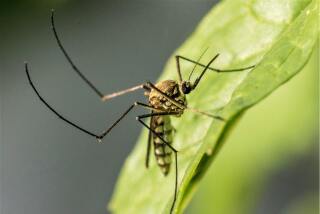Canine distemper in kit foxes spreads in Mojave Desert
The first documented outbreak of canine distemper in desert kit foxes has spread beyond its origins at a construction site west of Blythe and could take a heavy toll on the species, state wildlife biologists said Tuesday.
Biologists have nearly given up hope of containing the deadly virus. It was first diagnosed in October during construction at the $1-billion Genesis Solar Energy Project site, about 25 miles west of Blythe. Eight of the cat-sized foxes died there.
Since then, distemper has been detected in living kit foxes and two dead ones up to 11 miles south of Genesis, said Deana Clifford, wildlife veterinarian for the California Department of Fish and Game. Although 11 miles isn’t far in the Mojave Desert, spread of the disease even a few miles shows that efforts to stop it failed and it is now free to spread among the region’s large population of kit foxes.
“I am hopeful that a certain number of kit foxes will survive and develop a resistance,” Clifford said. “We are trying to figure out if the disease will calm down or trigger a new cycle among the next vulnerable group of animals: newborn pups that will wean in May or June.”
In a worst-case scenario, kit foxes could suffer an epidemic similar to one that nearly wiped out the island fox population on Santa Catalina Island in 1999. Thanks to aggressive steps by the Catalina Island Conservancy, including vaccinations and captive breeding, the wild fox population recovered nicely.
Tackling the disease on the mainland presents much greater challenges.
So far, nine desert kit foxes have been outfitted with radio collars featuring a mortality signal that pulses twice as fast as normal if the animal has not moved in six hours, biologists said. Twenty-nine desert kit foxes have received a vaccine specifically developed for use in species that are very sensitive to the virus.
But Clifford acknowledged that the state lacks the resources to monitor the entire desert.
Biologists are certain the outbreak began at Genesis. DNA analyses of tissue from the dead foxes should identify the strain of virus, which could provide clues about the host animal. It could have been a wandering dog or one accompanied by its owner, or possibly a wild badger or some other wild carnivore, biologists said.
State veterinarians have speculated that kit foxes at Genesis were more vulnerable to the disease because they were under the stress of hazing techniques used to force them from the site in advance of construction. Workers removed sources of food and cover, sprinkled urine from coyotes — a primary fox predator — around den entrances, and used shovels and axes to excavate about 20 dens that had been unoccupied for at least three consecutive days.
The possibility of a link between those techniques and the outbreak should prompt government officials to reevaluate methods of dealing with kit foxes at solar sites, said Lisa Belenky, senior attorney for the Center for Biological Diversity.
Once the disease was discovered at Genesis, electric wires were installed along the top of knee-high fences to discourage kit foxes from reentering the area where the outbreak occurred.
The electric wires were not completely effective, however. On Feb. 1, a biologist tracked the source of electronic signals from a radio-collared female kit fox to a large tool box in the bed of a truck on the work site, California Energy Commission officials said. The biologist asked the driver of the vehicle to open the tool box.
The driver said he could not because the keys were locked inside the box. The next morning, the biologist found the dead fox under a water tower about 100 feet from where the transmitter signal peaked the day before.
The state took no action because evidence of wrongdoing was inconclusive, commission spokeswoman Sandy Louey said.
A necropsy later found that the kit fox died of distemper, Clifford said.
Genesis spokesman Steven Stengel said the developer, NextEra Energy Resources, is working closely with state agencies on the outbreak.
More to Read
Sign up for Essential California
The most important California stories and recommendations in your inbox every morning.
You may occasionally receive promotional content from the Los Angeles Times.











